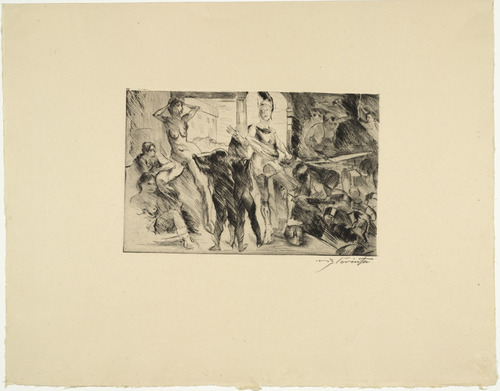THE COLLECTION
About this work
Heather Hess, German Expressionist Digital Archive Project, German Expressionism: Works from the Collection. 2011.
Lovis Corinth began work on Antike Legende (Classical legends) during the last few months of World War I. In twelve drypoints, he transformed mythological gods for the new age, reworking prints and paintings from earlier in his career in a new, Expressionist style and in light of new circumstances. The sensual and voluptuous images belie the deep malaise he felt as the political situation in Germany deteriorated. Privately, he complained that the political landscape "was becoming more and more ridiculous" and that it "crippled everything," including progress on this portfolio, a commission for Julius Meier-Graefe's Marées-Gesellschaft.
Corinth alluded to World War I and the misery it brought to Germany in Die Schmiede des Vulkan (The forge of Vulcan). In Die Spiegel der Venus (The mirror of Venus), the goddess of love transforms a weapon—the shield of Mars—into a tool for reflecting her own beauty. Corinth delighted in depicting luscious nudes. He revered Peter Paul Rubens, the Flemish master of ecstatic flesh, whose painting Perseus and Andromeda he copied for this portfolio. Corinth believed that art was ultimately more important than day-to-day realities: "True art has no practical, utilitarian aftertaste," he noted in a 1920 essay. "It exists solely for itself. Egotistical like a god, it stands before us in all its radiance and allows itself to be admired by its true devotees."
Lovis Corinth (German, 1858–1925)
The Forge of Vulcan (Die Schmiede des Vulkan) from Classical Legends (Antike Legenden)
- Date:
- 1919
- Medium:
- One from a portfolio of twelve drypoints with one additional drypoint (variant of plate 1)
- Dimensions:
- plate: 12 9/16 x 8 1/8" (31.9 x 20.6 cm); sheet: 19 x 24 1/8" (48.3 x 61.3 cm)
- Paper:
- Beige, smooth, laid Japan.
- Publisher:
- Marées-Gesellschaft, R. Piper & Co., Munich
- Printer:
- Alfred Ruckenbrod, Berlin
- Edition:
- 150 (including deluxe edition of 50 on Japan paper [this ex.] with additional plate and a regular edition of 100 on handmade "Bütten" paper)
- Credit Line:
- Gift of J.B. Neumann
- Reference:
- Schwarz 351 X.
- MoMA Number:
- 315.1956
- Themes:
- Literary Subjects, Postwar Politics
- Techniques:
- Intaglio



